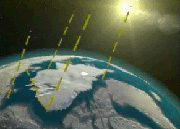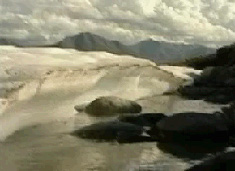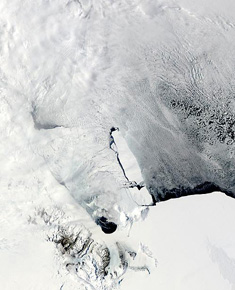| |

Recent warming of arctic may affect worldwide climate |
| |
NASA Press Release October 23 2003
Recently observed change in Arctic temperatures and sea ice cover may be a harbinger of global climate changes to come, according to a recent NASA study.
Satellite data - the unique view from space - is allowing researchers to more clearly see Arctic changes and develop an improved understanding of the possible effect on climate worldwide.
The Arctic warming study, appearing in the November 1st issue of the American Meteorological Society's Journal of Climate, shows that compared to the 1980s, most of the Arctic warmed significantly over the last decade, with the biggest temperature increases occurring over North America.
"The new study is unique in that, previously, similar studies made use of data from very few points scattered in various parts of the Arctic region," said the study's author, Dr Josefino Comiso, senior research scientist at NASA's Goddard Space Flight Center, Greenbelt, Maryland. |
| |
 |
| |
The global mean surface temperature has increased 0.5°F to 1.0°F since the late nineteenth century. |
| |
 |
| |
|
"These results show the large spatial variability in the trends that only satellite data can provide." Comiso used surface temperatures taken from satellites between 1981 and 2001 in his study.
Researchers have suspected loss of Arctic sea ice may be caused by changing atmospheric pressure patterns over the Arctic that move sea ice around, and by warming Arctic temperatures that result from greenhouse gas buildup in the atmosphere.
Warming trends like those found in these studies could greatly affect ocean processes, which, in turn, impact Arctic and global climate, said Michael Steele, senior oceanographer at the University of Washington, Seattle. |
| |

In the last decade, oceans and land surrounding the Arctic Ocean have warmed 1°C (2°F). The Ward Hunt Ice Shelf, the Arctic's largest, has broken up. It was in place on the north coast of Ellesmere Island in Canada's Nunavut territory for 3,000 years. |
|
Water absorbs the sun's energy rather than reflecting it into the atmosphere the way ice does. As oceans warm and ice thins, more solar energy is absorbed by water, creating positive feedbacks leading to more melting. These dynamics change the temperature of ocean layers, impact ocean circulation and salinity, and change marine habitats. |
|
|
| |
In related NASA-funded research that observes perennial sea ice trends, Mark Serreze, a scientist at the University of Colorado, Boulder, found that in 2002 the extent of Arctic summer sea ice reached the lowest level in the satellite record, suggesting this is part of a trend.
"It appears that the summer 2003 - if it does not set a new record - will be very close to the levels of last year," Serreze said. "In other words, we have not seen a recovery; we really see we are reinforcing that general downward trend." A paper on this topic is forthcoming.
According to Comiso's study, when compared to longer term ground-based surface temperature data, the rate of warming in the Arctic over the last 20 years is eight times the rate of warming over the last 100 years.
Comiso's study also finds temperature trends vary by region and season. While warming is prevalent over most of the Arctic, some areas, such as Greenland, appear to be cooling. Springtimes arrived earlier and were warmer, and warmer autumns lasted longer, the study found. |
|
|
Most importantly, temperatures increased on average by 1.22°C per decade over sea ice during Arctic summer. The summer warming and lengthened melt season appears to be affecting the volume and extent of permanent sea ice.
Annual trends, which were not quite as strong, ranged from a warming of 1.06°C over North America to a cooling of 0.09°C in Greenland.
If the high latitudes warm, and sea ice extent declines, thawing Arctic soils may release significant amounts of carbon dioxide and methane now trapped in permafrost, and slightly warmer ocean water could release frozen natural gases in the sea floor, all of which act as greenhouse gases in the atmosphere, said David Rind, a senior
researcher at NASA's Goddard Institute of Space Studies, New York. "These feedbacks are complex and we are working to understand them," he added. |
| |
 |
| |
Global warming trends
Global mean surface temperature has increased 0.5°F to 1.0°F since the late 19th century.
The 10 warmest years all occurred in the last 15 years of the 20th century.
1998 was the hottest year since records have been kept.
Globally, sea level has risen 4-8 inches during the last century.
Worldwide rainfall over land has increased by about one percent.
The frequency of extreme rainfall events has increased. |
| |
 |
| |
 |
|
Above: The two composite images compare concentrations of sea ice over the Arctic Circle in 1979 (left) and 2003 (right).
The result has direct connections to NASA studies conducted last year that found perennial, or year-round sea ice in the Arctic is declining at a rate of 9 percent per decade, and that in 2002 summer sea ice was at record low levels. Early results indicate that low levels persisted in 2003.
Images courtesy of Scientific Visualizations Studio, NASA GSFC
 Click on image to view larger Click on image to view larger |
| |
 |
Polar regions reveal the reality of global warming .....
The Arctic polar ice cap is melting at an alarming rate, as a result of human caused global warming. The polar regions are Earth's most useful climate change laboratory, sending warnings to the world.
Climatologists predicted 30 years ago that warming of the Earth would be more prominent at the poles. They have been proven correct, with convincing evidence of rapid changes that are happening now.
Changes in polar ice can alter ocean chemistry, circulation patterns in the atmosphere and oceans, and world weather systems. The polar regions are the thermostat of the world. The thick blankets of ice play a part in regulating the earth's overall temperature, but this equilibrium may be shifting.
An overall decrease in sea ice in Antarctica during the last three decades, has not been evened out by increases since the late 1970s that followed large reductions.
The most notable is the warming trend in the Ross Sea, where massive icebergs have broken off from the Ross Ice Shelf. Climate change is more complex in Antarctica, and a definitive overall temperatute increase cannot be defined.
It is known from ancient air bubbles trapped in the ice cores of Antarctica's interior, that there is now more carbon dioxide in the atmosphere than at any time during the last 40,000 years. |

The massive 100-mile Antarctic B15A iceberg .....
which has blocked shipping routes to McMurdo Station, appeared in a NASA image to be
intact on October 7 2003, and broken in two on October 9. The largest section is
about 75 miles long and the shorter piece is 25 miles long.
The B15A iceberg broke off the Ross Ice Shelf in 2000 and drifted to
its present location. It was one of the largest icebergs scientists had ever observed
breaking from the shelf. A second large iceberg, C19, also trapped sea ice in the
passage but swung out to sea in 2002.
The Ross Ice Shelf is a vast field of snow and ice extending from the
continent into the Ross Sea on the west Pacific coast of Antarctica. As glaciers
slide off the continent and push the shelf out, the outer edges crumble into a myriad of
icebergs.
 See a series of NASA images of the B15A iceberg
See a series of NASA images of the B15A iceberg
 See more on the C19 iceberg See more on the C19 iceberg
Huge Antarctic iceberg makes a big splash on sea life 1 October 2003
NASA Goddard Space Flight Center |
| |
Antarctic and Arctic sea ice is changing differently
A 30-year satellite record of sea ice in the two polar regions reveals that while the Arctic ice has melted, Antarctic ice has increased in recent years. However, due to dramatic losses of Antarctic sea ice between 1973 and 1977, the total average sea ice in both hemispheres has shrunk over the last 30 years.
The rate of loss in the Arctic for the last two decades is 20 percent greater than the rate of loss over the last three decades.
From 1972 to 2002, the Arctic sea ice decreased each decade by 300,000 sq km (116,000 sq miles), roughly the size of the State of Arizona. However, between 1979 and 2002 the sea ice area shrunk by a greater rate of 360,000 sq km (139,000 sq miles) each decade.
The greater rate of sea ice loss in the Arctic may be due to a general warming trend, as well as the influence of long-term oscillations or other changes in atmospheric pressure systems, which could pull in more warm air from the south.
In contrast, there was a dramatic loss of Antarctic sea ice from 1973 to 1977, but it has since gradually spread in area. Overall, from 1972 to 2002, the Antarctic ice declined on average by 150,000 sq km per decade (almost 58,000 sq miles).
The gradual advance of Antarctic ice from the late 1970s may be related to long-term atmospheric oscillations in the Southern Hemisphere resulting in stronger westerly winds and cooler temperatures. |
|
| |
 |
| |
|


